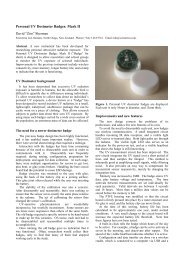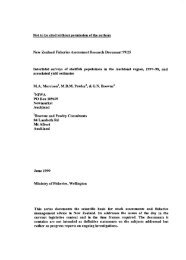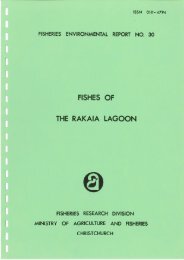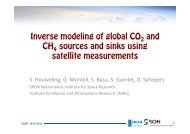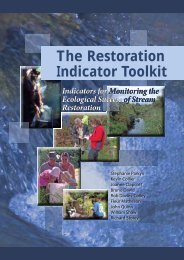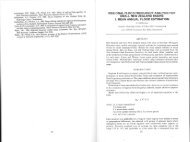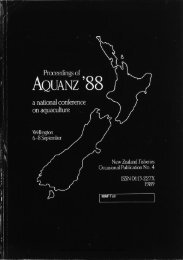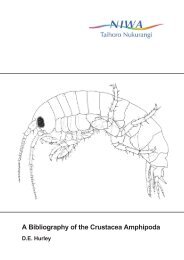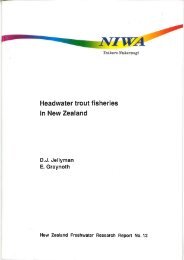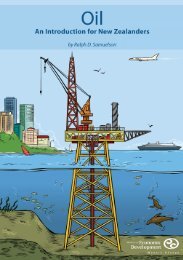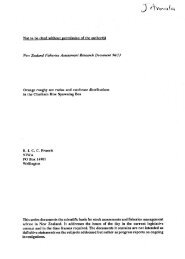WATER & SOIL - These are not the droids you are looking for.
WATER & SOIL - These are not the droids you are looking for.
WATER & SOIL - These are not the droids you are looking for.
You also want an ePaper? Increase the reach of your titles
YUMPU automatically turns print PDFs into web optimized ePapers that Google loves.
Table 3.9 The grouping and <strong>the</strong> group equations <strong>for</strong> est¡mation CF.<br />
GROUP<br />
West N.l.<br />
East N.l.<br />
West S.l.<br />
East S.l.<br />
NOTES:<br />
Regions whose<br />
Data were<br />
Regions Represented<br />
Pooled Toge<strong>the</strong>r by <strong>the</strong> Group<br />
1<br />
3,4 2. Bay of Plenty<br />
3. North ls. East Coast<br />
4. Central Hawke,s Bay<br />
5 5. South ls. West Coast<br />
6, 7, I 6. South ls. Easr Coast<br />
7. South Canterbury<br />
L Otago-Southland<br />
Group<br />
C¡ Equation,<br />
C.=<br />
1. Combined N.l. West Coast (O.94+3.93/nT)/1OO<br />
(- 1.25 +5.74fnTl<br />
/100<br />
12.46 +2.25tnTll1OO<br />
(2.61 +4.54/nT)/1OO<br />
+ indicates significance at <strong>the</strong> 1 7o level<br />
S.E. Est. is <strong>the</strong> standard error of estimate of C¡<br />
No. of stations is <strong>the</strong> total number used in <strong>the</strong> derivation of <strong>the</strong> group equation.<br />
S.E.<br />
R2 t Est.<br />
o.993 27.O* O.OO15<br />
0.984 17.7' O.O0g2<br />
0.992 25.2+ O.OO24<br />
o.985 18.1* 0.0068<br />
No. of C¡ value<br />
Stations <strong>for</strong>T=1OO<br />
65<br />
20<br />
2'l<br />
29<br />
o.1 I<br />
o.25<br />
o.1 3<br />
o.24<br />
than to obtain individual estimates of er/Q beyond a re_<br />
turn period of 100 years, which would have involved a gross<br />
extrapolation with several of <strong>the</strong> records.<br />
C¡ equations <strong>for</strong> estimating standard errors associated<br />
with <strong>the</strong> application of <strong>the</strong> generalised curves were also de_<br />
rived, and in exactly <strong>the</strong> same manner and with <strong>the</strong> same<br />
data as that used <strong>for</strong> <strong>the</strong> regional C¡ equations. Details of<br />
<strong>the</strong> resulting CF equations <strong>are</strong> given in iable 3.10.<br />
From a comparison of <strong>the</strong> coefficients of f nT in <strong>the</strong><br />
le 3.<br />
can be seen that<br />
<strong>for</strong><br />
rve produces CF<br />
thin<br />
given by <strong>the</strong> twô<br />
that<br />
<strong>are</strong>a. This result<br />
was <strong>not</strong> surprising, since a generalised curve <strong>for</strong> an <strong>are</strong>a<br />
represent<br />
that <strong>are</strong>a,<br />
and so it<br />
erages <strong>the</strong><br />
scatter in<br />
plo-ts. Be_<br />
cause of<br />
d that <strong>the</strong><br />
Never<strong>the</strong>less, some of <strong>the</strong> curves and <strong>the</strong> associated regional<br />
boundaries can<strong>not</strong> be regarded as definitive because<br />
of small data samples, a lack of samples, and a poor <strong>are</strong>al<br />
distribution of <strong>the</strong> flow stations' catchmenti (section<br />
3.4.3). In fact, <strong>the</strong> study exposed a number of <strong>are</strong>as where<br />
ef<strong>for</strong>ts to acquire flood peak data should be concentrated<br />
in <strong>the</strong> future.<br />
In <strong>the</strong> South Island <strong>the</strong>re were very few flow stations on<br />
<strong>the</strong> coastal plains of <strong>the</strong> east coast. Here <strong>the</strong>re <strong>are</strong> practical<br />
difficulties in estabtishing flow stations because <strong>the</strong> alluvial<br />
3.4.3 Definition of flood frequency<br />
reg¡onal boundaries<br />
As mentioned in section 3.3. I , use was made of available<br />
3.4.2 Data limitations<br />
most<br />
ever<br />
data<br />
rves.<br />
Island regions. A difference in <strong>the</strong> flood frequency trend<br />
between <strong>the</strong> North Island stations in <strong>the</strong> west änd those in<br />
<strong>the</strong> east was also evident.<br />
Table 3.1O The C¡ equations derived <strong>for</strong> <strong>the</strong> generalised curves.<br />
Area<br />
Western NZ<br />
Eastern NZ<br />
cF<br />
cF<br />
Equation<br />
S.E.<br />
R R2 t est.<br />
= (2.06+3.59fnT)/1OO 0.991 O.9Bt 16.3* 0.0060<br />
= (1.79 +4.84hrV1OO 0.996 0.992 26.8* O.OO49<br />
Water & soil technical publication no. 20 (1982)<br />
No. of<br />
stations<br />
86<br />
61<br />
48



